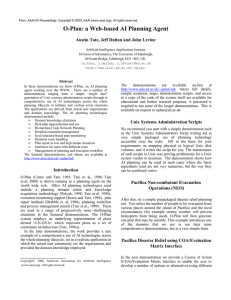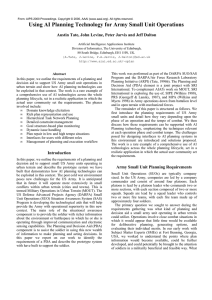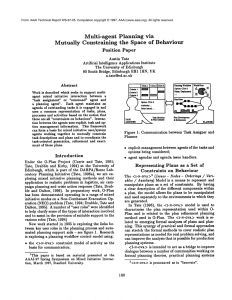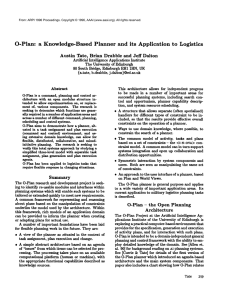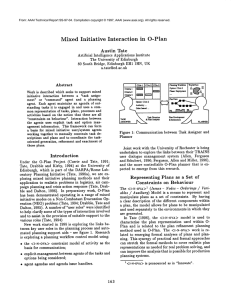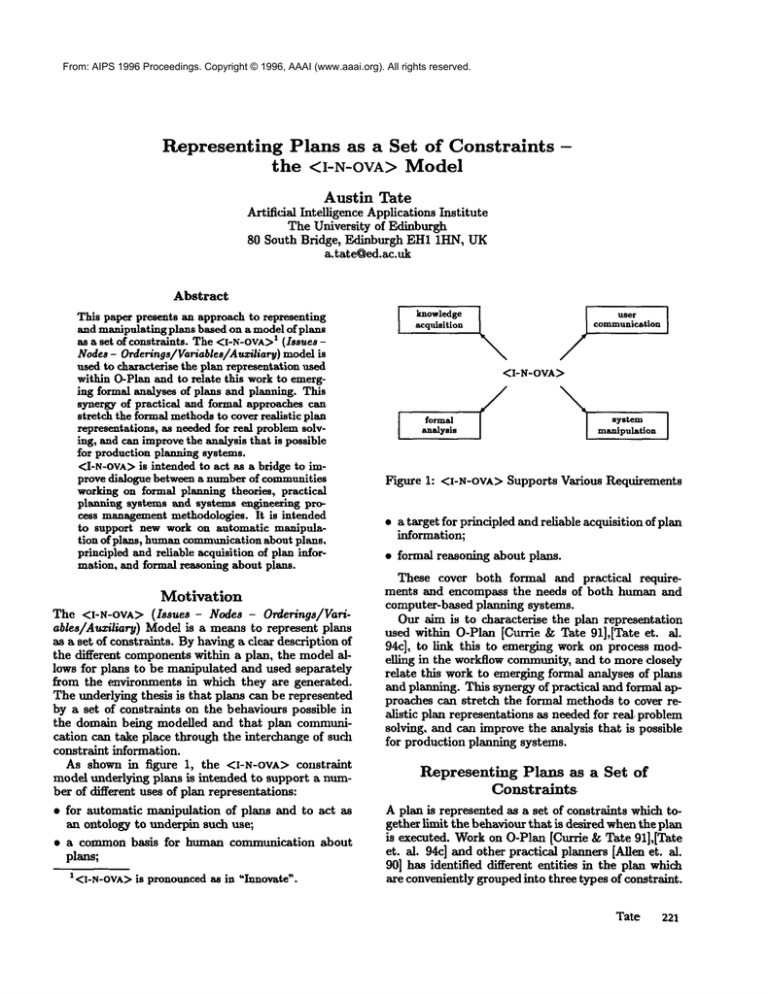
From: AIPS 1996 Proceedings. Copyright © 1996, AAAI (www.aaai.org). All rights reserved.
Representing
Plans as a Set of Constraints
the <~I-N-OVA> Model
-
Austin Tate
Artificial Intelligence Applications Institute
The University of Edinburgh
80 South Bridge, Edinburgh EH1 1HN, UK
a.tate~ed.ac.uk
Abstract
This paper presents an approach to repr~enting
and manipulatingplans based on a modelof plans
as a set of constraints. The <I-N-OVA>1 (Issues
Nodes - Orderlngs/Variables/Auziliary) modelis
used to cha~acte~isethe plan representation used
within O-Plan and to relate this work to emerging formal analyses of plans and planning. This
synergy of practical and formal approaches can
stretch the formal methodsto cover realistic plan
representations, as neededfor real problemsolving, and can improvethe analysis that is possible
for production planning systems.
<I-N-OVA>
is intended to act as a bridge to improve dialogue between a numberof communities
working on formal planning theories, practical
pl~ug systems and systems engineerlng process managementmethodologies. It is intended
to support new work on automatic manipulation of plans, humancommunicationabout plans,
principled and reliable acquisition of plan information, and formal reasoning about plans.
Motivation
The <I-N-OVA> (IssuesNode8 - Orderings/Variables/Auziliary) Model is a metals to represent plans
as a set of constraints. By having a clear description of
the different components within a plan, the model allows for plans to be manipulated and used separately
from the environments in which they are generated.
The underlying thesis is that plans can be represented
by a set of constraints on the behaviours possible in
the domain being modelled and that plan communication can take place through the interchange of such
constraint information.
As shown in figure 1, the <I-N-OVA>constraint
model underlying plans is intended to support a number of different uses of plan representations:
¯ for automatic manipulation of plans and to act as
an ontology to underpin such use~
¯ a common basis for human communication about
plans;
1 ~.
<I-N-OVA>
is pronouncedas in ~Innovate
communication
acquisition
<I-N-OVA>
~
formal
analysis
Figure I:
~/~
<I-N-OVA>
[
system
manipulation
Supports Various Requirements
¯ a target for principled and reliable acquisition of plan
information;
¯ formal reasoning about plans.
These cover both formal and practical requirements and encompass the needs of both human and
computer-based planning systems.
Our aim is to characterise the plan representation
used within O-Plan [Currie & Tare 91],[Tate et. al.
94c], to link this to emerging work on process modelling in the workflow community, and to more closely
relate this work to emerging formal analyses of plans
and planning. This synergy of practical and formal approaches can stretch the formal methods to cover realistic plan representations as needed for real problem
solving, and can improve the analysis that is possible
for production planning systems.
Representing Plans as a Set of
Constraints
A plan is represented as a set of constraints which together limit the behaviour that is desired whenthe plan
is executed. Workon O-Plan [Currie & Tare 91],[Tare
et. ai. 94c] and other practical planners [Allen et. al.
90] has identified different entities in the plan which
are conveniently groupedinto three types of constraint.
"Fate
221
From: AIPS 1996 Proceedings. Copyright © 1996, AAAI (www.aaai.org). All rights reserved.
The set of constraints describes the possible plan elaborations that can be reached or generated as shownin
figure 2.
Plan State
Implied
Constraints
Plan Agenda
Main Plan
Constraints
Plan Entities
Detailed
Constraints
IIP,Ooo-,.
//Space of Legitimate N~
Plau Elaborations
Figure 2: Constraints Define the Space of Plan Elaborations
The three types of constraint in a plan are:
1. Implied Constraints or "Issues ~ ~ - representing the
pending or future constraints that will be added to
the plan as a result of handling unsatisfied requirements, dealing with aspects of plan analysis and critiquing, etc. The implied constraints are the issues
to be addressed, i.e., the "to-do~ list or agenda which
can be used to decide what plan modifications should
be made to a plan by a planner (user or system).
2. Plan Entities or Plan Node constraints - the main
plan entities related to external communicationof a
plan. They describe a set of external names associated with time points. In an activity planner, the
nodes are usually the actions in the plan associated
with their begin and end time points. In a resource
centred scheduler, nodes may be the resource reservations made against the available resources with a
begin and end time point for the reservation period.
2Wehave previously used a variety of different names
for these constraints: AgendaEntries reflecting the chosen
methodof representation in O-Plan; Flaws as suggested by
SamSteel of Essex University in the mid 1980sand reflecting the original concentration of representing the outcome
of plan critics which found interactions in the teleological structure that had to be corrected; To-do list entries
reflecting commonusage in business; Pending Processing
Requirementsreflecting the notion that they implied future
plan manipulationor constraints; and others. Wehave settled on Issues suggested by Craig Wler of ARPAin 1994
as being an easily understood term that reflects both the
need to handle problemsand the positive opportunities that
present themselves.
222 AIPS-96
3. Detailed Constraints - associated with plan entities
and representing speciaiised constraints on the plan.
Empirical work on the O-Plan planner has identified
the desirability of distinguishiug two special types of
detailed constraint:
¯ Ordering or Temporal Constraims (such as temporal relationships between the nodes or metric
time properties).
¯ Variable Constraints (especially co-designation
and non-co-designation constraints on plan objects).
These two constraint types are higiflighted since
they may form part of other constraints within a
temporal reasoning domain such as occurs in planning and scheduling problems. Knowing that these
constraints have such "cross-associations" has been
found to simplify the design of constraint handling
mechanisms and ease intplementation issues [’rate
93b],[Tate et. al. 94d].
Other Detailed Constraints relate to input (pre-)
aald output (post-) and protection conditions, resources, authority or control requirements, spatial
constraints, etc. These are referred to as:
¯ Auxiliary Constraints
Atudliary Constraints may be expressed as occurring
~"
at ) a time point (referred to as "point constraints
or across a range of the plan (referred to as "range
constraints"). Point constraints can be used to express input and output constraints on nodes or for
other constraints that can be expressed at a single
time point. Range constraints relate to two or more
time points and can be used to express protection
intervals, etc.
The <~I-N-OVA~>Model
A pla~l is represented as a set of constraints of three
principal types. To reflect the three main types of constraint identified and their differentiation in the model
the constraint set for a plan is written as <I-N-OVA>
(Issues- Nodes- Orderings/Variables/Auziliary).
stands for the the issues agenda or inlplied constraints,
N for the node or plan entity constraints, and OVAfor
the detailed constraints held as three types (O for ordering constraints, V for variable constraints, mid A
for the other auxiliary constraints).
The auxiliary constraints are given 4 sub-types: Authority, Conditions, Resources and Other mid all may
be stated as point (related to a single time point),
range (related to two time points) or multi-point constraints. Fhrther sub-types are possible for any of the
Auxiliary Constraints and the nature of these reflects
on-going work on knowledge modelling for planning,
scheduling and process modelling domains (e.g., [Tare
93a], [Tare et. al. 94b], [Uscholdet. el. 95]).
From: AIPS 1996 Proceedings. Copyright © 1996, AAAI (www.aaai.org). All rights reserved.
The <I-N-OVA>
constraint
modelforplvaascontains
a hierarchy
of constraint
typesandsub-types
as follows:
Plan
Constraints
90],HOOD[HOOD89],etc.),and to recentworkon
Process
Interchange
Format(PIF)[PIF94],workflow
standards
[WflVIC
94]andenterprise
modelling
frameworks[gschold
et.al.1995].
I - Implied
Constraints
N - Node Constraints
OVA - Detailed
Constraints
0 - Ordering
Constraints
V - Variable
Constraints
A - Auxiliary Constraints
- Authority Constraints
- subtypes
- Condition Constraints
- subtypes
- Resource Constraints
- subtypes
- Other Constraints
- subtypes
The node constraints in the <I-N-OVA>model set
the space within which a plan may be further constrained. The issues and OVAconstraints restrict the
plans within that space which are valid.
The <I-N-OVA>model currently assmnes that it is
sufficiently general for each node (referred to as N constralnts) to be associated with just two time points,
one representing the begin of the node and the other
representing the end of the node. Further research may
indicate that a more general, multiple time point association of nodes to time points may be necessary.
Hierarchical or abstraction level modelling is po~
sible for all constraint types within the <I-N-OVA>
model.To reflect
thispossibility,
an <I-N-OVA>
model
whichis described
hierarchically
orwithlevels
of abstraction
willbe referred
to as a Hierarchical
<I-NOVA>model.Thiswillbe writtenas A-<I-N-OVA>.
TheA is a triangle
pictogram
usedto represent
hierarchical
expansion.
It canbe written
in an alternate
allcharacter
version
as H-<I-N-OVA>.
The Triangle
Model of Activity
The <I-N-OVA>auxiliary constraints ittcorporate details from the Triangle Model of Activity used to underpin the Task Formalism (TF) domain description
language [Tale et. al. 94a] used for O-Plan [Currie &
Tale 91],[Tate et. al. 94c]. The Triangle Model seeks
to give a clear description of activities, tasks and plans
in a commonframework that allows for hierarchical
decomposition and time relationships along with authority, pre- and post-conditions, resources and other
constraints. The Triangle Model can be used as a basis
for planning domain modelling and for supportive task
description interfaces.
The aim in the Triangle Modelis to simplify some of
the notions for expressive plan and activity representations from AI planning. It seeks to relate these notions to existing systems-engineering requirements capture and modelling languages and methods (like SADT
[ROSS 85],IDEF[Mayer & Painter
91],CORE[Curwen
activity
.l
context
~____~
authority
effects
authority
conditions resources
resources
w time
Figure 3: O-Plan Triangle model of Activity
Figure 3 shows the Triangle Model of Activity. The
vertical dimension reflects activity decomposition, the
horizontal dimension reflects time. A context allows
for the relevance of a particular decomposition to be
made to depend on the situation in which it may be
used. Inputs and outputs are split into three principal categories (authority, conditions/effects and resources). Arbitrarily complex modelling is possible in
all dimensions. Types and sub-types are used to further differentiate the inputs and outputs, and their semantics.
"Entry ~ to the model can be from any of the three
points in the triangle: it can be used from the top vertex to ask for activity expansions or decompositions,
or from the right side to ask for activities satisfylug
or providing the output requirement (authority, goal
or resource). These two points are used mostly by AI
planners to date. The third point from the left side
cm~ reflect non-intended triggering conditions for an
action and will be needed when improved independent
processes are modelled within planers as in the EXCALIBUR[Drabble 93] extension to Nonlin [Tale 77].
The activity decompositions shows the expansion of
the activity to a greater level of detail if that is modelled. It can include details of protection conditions
that span points within a decomposition.
Variables mayappear in an activity description. Differentiation between those variables used in the externai specification (outside the triangle) and those only
used within the activity decomposition (internal to the
triangle) is possible.
The O-Plan time model defines a set of time points
which can be related to an absolute start of time (for
metric time statements) or which can be related to
one another (for relative time relationships ). Temporal
Tare 22.3
From: AIPS 1996 Proceedings. Copyright © 1996, AAAI (www.aaai.org). All rights reserved.
relationships between an activity (referred to as self)
and the sub-activities within a decomposition may be
stated with reference to the two "ends" of ally activity. Arbitrarily complex temporal relationships (e.g.,
[Allen & Koomen93]) are possible in the generM Triangle Model.
The "intentions" or ~rationale:’ behind the use of a
particular activity can be related to the features of this
Triangle Model. Causality or teleology modelled via
activity pre-conditions/post-conditions
has been used
in AI planners for manyyears to record the plall rationaie (e.g., in Nonlin [Tate 77]). Ill the richer modelnow
in use in O-Plall, rationale in terms of resource usage
and supply, authority requirements or delegation may
also be stated. This makes it possible to use a uniform
approach to the modelling of authority, product flow
¯’md resource requirements.
The Triangle Model of activity maps directly to an OPhm TaskFormalism
(TF) schema.TF is the dolnain
description
language
for O-Plan.
Thefollowing
shows
thecomponents
of a simplified
sdmma.%.."indicates
repetition
of theprevious
component.
Further
detail
isavailable
in[Tate
et.ai.94a].
;
;
;
; ; ; private
information
local_vats
<vat> = <vat_restriction>,...
;
vats_relations
<v~r> <relation>
<var>,...
;
nodes
<node_number> <node_form>,...;
orderings
<node_end> ---> <node_end>,...;
time_windows
<time_window_spec>,...;
authority
<authority_statement>,...;
conditions
<condition_statement>,...;
effects
<effect_statement>,...;
resources
<resource_statement>,...;
other_constraints <constraint_statement>,...;
end_schema;
Domain Operators,
Figure 4 illustrates
tween domain, task
Plmls are both based
nmdel. Plans also al’e
Tasks and Plans
the dependency relationships beand plan knowledge. Tasks and
upon the entities in the Domain
elaborations of a specific Task.
. Domainklmwledge describes "fixed ~ things like facilities, organisational relationships, procedures, systems, products alid the types of resource available.
This knowledge is likely to be highly reusable for
many ditferent requirements.
224 AIPS-96
Z
(
Task
)
Phm/
Figure 4: Dependencies between Domain, Task mid
Plan Knowledge Partitions
Relationship of Triangle Model to
O-Plan TF Schemas
schema <schema_name>;
; ; ; public information
vars
<var> - <var_restriction>,. .. ;
expands <pattern>
;
only_use_for_authority
<authority_statamemt>,...
only_use_for_effects
<effect_statement>,...
only_use_for_resources
<resource_statement>,...
( Domain)
¯ Task knowledgedescribes the objectives such as the
goal or goals which the plan is designed to achieve,
the activity to be carried out, the actual resources
available, the time available, etc.
¯ Plan knowledgedescribes a particular way (currently
under exploration) in which the specified task objectives can be achieved in the current domain.
<I-N-OVA>iS intendedto underpindomain,task
andplallmodelling
needsin a planning
system
whether
human,computer
or mixedagentsare involved.
Comnmnication
betweenplanning
agentsin O-Plantakes
placeviaPlallPatches
[Tare89]whichare"alsobased
on theTriangle
Modelof Activity
andthe <I-N-OVA>
constraint
components.
Relationship of <I-N-OVA>to Workin
Systems Engineering
There is a deliberate and direct mapping from the OPlan Triangle Model of Activity and the <I-N-OVA>
Constraint Modelof Plalm to existing structured analysis and diagraming
methodssuch as IDEF and RCharts.Otherresearchers
haverccognised
the value
of merging
AI representation
concepts
withstructured
analysis and diagranmfing techniques for systems requirements lnodelling [Borgida st. al. 85],[Ilamesh &
Dhar 94] and the earlier work on the Progranmmr’s
Apprentice [Rich & Waters 88].
Modelling Processes and Activities
IDEF0[Mayer92]is a functional
modelling
method
mid
diagrmning
notation
thathasbeenusedformodelling
3. Figure5 showsthebasiccomponent.
processes
3IDEF3
[Mayer
& Painter
91]is a later,
morecomprehe.nsive IDEF methodspecifically targeted at the modelling
of processes.
From: AIPS 1996 Proceedings. Copyright © 1996, AAAI (www.aaai.org). All rights reserved.
which uses the IBIS (Issue-based Information System)
concepts. The issues are explicitly maintained as in the
<~I-N-OVA~>model, and the Remapsystem allows for
the ways in which the issues are resolved to be recorded
and used.
control
L
input
activity
" decomposition
~ output
Relationship
to Other Work
A general approach to designing AI-based planning
and scheduling systems based on partial plan or partial schedule representations is to have an architecture
in which a plan or schedule is critiqued to produce a
list of issues or agenda entries which is then used to
drive a workflow-style processing cycle of choosing a
~plan modification operator" and then executing it to
modify the plan state. Figure 7 shows this graphically.
mechanism
Figure 5:IDEF0 model
IDEFmodellers usually use ~contror’ for authorityrelated triggers and ~mechanism"to reflect resource
availability. A criticism of IDEFis the lack of direct
support for modelling the different types of output and
their intended destination.
Experienced IDEF modellers use the arc labels, naming conventions and the
~notes" system in an IDEFsupport ~kit "~ to encode this
information.
R-Charts [Ushakiv & Velbitskiy 93] are one of the
ISO approved diagraming conventions for progrmn
constructs (ISO/IEC 8631 [ISO/£SC 89]). Figure
shows the basic component which explicitly acknowledges the importance of control (or authority) related
outputs.
PlanState
Implied
Constraints
Plan Agenda
Plan Level
Constraints
PlanEntities
J
Detailed
Constraints
Plan
Constraints
I
/
control input
, Choose(PMO)
Do(PMO)
x’~
Spaceof Legitimate
PlanElaborations
Figure 7: A Framework of Components in a Planning/Scheduling System
data input
design
unit
¯
T
resources
t
1
data outimt
control output
Figure6: R-ChartModel
The ()-Plazl Triangle Model represents all three
types of input and output more uniformly and directly
and will allow for improved support tools.
Capturing
Design Rationale
in Systems
Development
Workin systems enginering and other fields is addressing the need to capture and make use of the rationale
behind designs, decisions or regulations. An example
is the Remap(for "Representation and maintenance
of processes knowledge" ) system [Ramesh & Dhar 94]
This approadl is taken in systems like O-Plan [Curtie & Tate 91],[Tate et. al. 94c], RT-1[D’Ambrosioet.
ai. 87l, oPIS [Smith 94l, DIPART
[Pollack 94l, TOSCA
[Beck 93], etc. The approach fits well with the concept
of treating plans as a set of constraints which can be
refined as planning progresses. Somesuch systenm can
act ill a non-monotonicfashion by relaxing constraints
in certain ways.
Having the implied constraints or "agenda" as a formal part of the plan provides an ability to separate the
plan that is being generated or manipulated from the
planning system itself. The benefits were first noted
by McDermott [McDermott 78] and are used as a core
part of the ()-Plan design.
A recently described approach to Mixed Initiative
Planning in O-Plan [Tate 94] proposes to improve the
coordination of planning with user interaction by employing a clearer shared model of the plan as a set of
constraints at various levels that can be jointly and explicitly discussed between and manipulated by user or
system in a cooperative fastdon.
]’ate
225
From: AIPS 1996 Proceedings. Copyright © 1996, AAAI (www.aaai.org). All rights reserved.
Relationship
to Formal Studies
of Plans
and Planners
The Nonlin QAAlgorithm [Tate 77] establishes the
modifications that are needed in terms of plan step
ordering and variable binding to ensure that a given
statement has a required value at a given point in a
partially ordered network of nodes. This has been a
basis for the formal work by Chapman [Chapman 91]
on the Modal Truth Criterion. However, the MTCuses
a simplification of the plans being represented in practical planners
such as Nonlin [Tare 77], O-Plan [Currie & Tare 91],[Tate et. al. 94c] and SIPS-2 [Wilkins
88]. It took a non-hierarchical view and ignored specialised domain knowledge of activity condition types
and constraints.
Manyof these were those very features that allowed planners like Nonlin and SIPS.-2 to
solve problems at a scale that was beyond the more theoretically
based planners. Drummond[Drummond93]
explains that formal approac.hes have concentrated on
goal achievement aspects of planners in a simplified environment that is not representative of the approaches
actually taken in practical planners.
Recently however, formal representations have begun to address issues of realistic plan representations
and to model hierarchical planning [Barrett & Weld
94],[Kambhampati & Hendler 91],[Penberthy & Weht
90], [Yang 90]. In particular,
Kambhampati has described a formal truth criterion for plans which are
represented with greater levels of realism. He describes
plans as a 5 tuple <S, O, B: ST, L> [Kanlbhampati
94a] where:
S
a set of plan steps or nodes
0
a partial ordering over S
a set of variable binding co-designation
and non-co-designation constraints
ST
a symbol table mappinK each plan step or
node to a domain operator
L
a set of auxiliary constraints (mainly
intended for pre- and post-conditions)
This representation can be related directly to the
N (incorporating the S and ST parts) and OVA(incorporating the O, B and L parts) of the <I-N-OVA>
4.
model
Hendler and Kaxnbhvanpati are also studying hierarchical approaches to formal methods in planning
[Kambhampati 94b],[Kanlbhampati
& Hendler 91].
Work is underway by Kanlbhampati and by Young
4The use of the term "Auxiliary Constraints" in <IN-OVA>
was adopted as a means to relate to this formal
work. In fact the <S, O, B, ST, L>constraint set acts as a
refinement filter on all possible plans, whereas<I-N-OVA>
also defines the candidate set from whichthe solutions may
come(through the N component). This needs further study
to relate the two approaches.
226 AIPS-96
[Young et. al. 94] to understand aspects of the use
of "condition types" [Tate et. al. 94b] used to provide
domain semantic information to Nonlin, O-Plan mid
other practical plmmexs.
The <I-N-OVA>model also has a direct relationship to the plan recipes described by Tramnmid Allen
[Tranm& Allen 94]. They view plmmas a set of actions
(c.f. N) and a set of constraints relating various properties of these actions (c.]. OVA).The issues element
{I) of <I-N-OVA>
is not directly nmdelled.
A Framework for
Further
Study
To provide a franmworkfor further study, the following classification of models related to <I-N-OVA>
is
)rovided.
partial plan
partial plan
with issues
single level model
tfierarchical
<N-OVA>
model A-<N-OVA>
<I-N-OVA>
A-<I-N-OVA>
A base model <N-OVA>
i8 used to represent a basic
plan without hierarchy or abstraction modelling and
not including implied constraints (the issues agenda).
The other models extend this basic model along these
two dimensions 5. They are all supersets of <N-OVA>,
and are collectively termed SUper-<N-OVA> models.
The <N-OVA>
element most closely relates to the
model being studied by Kambhampati today [Kambhampati 94a]. The A-<I-N-OVA>
clement is the closest
to the plan representation used within O-Plan today.
Summary
The <I-N-OVA>Constraint Model of Plans and its relationship to the O-Plan Triangle Model of Activity
has been described to assist in more closely relating
new work in forlnal descriptions of plans and planners
to practical work on realistic planning systems. <I-NOVA>
is intended to act as a bridge to improve dialogue
between the communities working in these two areas
and potentially to support work on antomatic manipulation of plans, hmnmlcommunication about plans,
principled a~ld reliable acquisition of plan information,
and formal reasoning about plans.
Acknowledgements
The O-Plan project is sponsored by the Advanced
Research Projects Agency (ARPA) and RomeLabora5Non-determinismis a property of the system {human
or computerbased)
which manipulates the plans and is not
necessarily represented in the constraint model. However,
it is usual to include explicit dependencyinformation in
a plan via constraints to support non-monotonicplanners.
This mayindicate that it wouldbe useful to define a third
dimensionto this frameworkfor further study.
From: AIPS 1996 Proceedings. Copyright © 1996, AAAI (www.aaai.org). All rights reserved.
tory, Air Force Materiel Command,USAF,under grant
number F30602-95-1-0022. The O-Plan project is
monitored by Dr. Northrup Fowler III at the USAP
RomeLaboratory. The u.s. Government is authorised
to reproduce and distribute reprints for Governmental purposes notwithstanding any copyright annotation
hereon. The views and conclusions contained herein
are those of the authors and should not be interpreted
as necessarily representing official policies or endorsements, eitherexpress
or inlplied,
of ARPA,RomeLaboratoryor the u.s.Government.
Theworkhas alsobenefited
fromdiscussions
concerningthe use of knowledge-rich
planand process
representations
in commercial
applications
thoughcollaboration
in theEnterprise
project[Fraser& Tate
95].Enterprise
is a consortium
including
AIAI,IBM,
Unllever,
Logica
andLloyds’
Register
andis supported
by theU.K.Government’s
Intelligent
Systems
IntegrationProgramme.
My thanksto the researchers
on the O-PlanandEnterprise
projects and for discussions with researchers
elsewhere which have helped formulate the <I-N-OVA>
model
References
[Allen
et.al.90]Allen,
J.F.,Hendier,
J. andTate,A.,
Readingsin Planning,
MorganKaufmann,
Palo Alto,
CA., 1990.
[Allen & Koome~a93] Allen, J.F. and Koomen, J.A.,
Planning Using a Temporal World Model, Proceedings
of the International Joint Conference on Artificial Intelligence (IJCAL83), Karlsruhe, Germany, 1993.
[D’Ambrosio et. al. 87] D’Ambrosio, B., Raulefs, P.,
Fehling, M.R., and Forrest, S., Real-time Process Management for Materials Composition in Chemical Manufacturing, Technical Report, TechnowledgeInc: 1850
Embarcadero Road, Palo Alto, CA 94303 and FMC
Corporation, AI Center, Central Engineering Laboratories, Box 580, 1205 Coleman Avenue, Santa Clara,
CA95052, USA, 1987.
[Barrett & Weld 94] Barrett, A. and Weld, D.S., TaskDecomposition via Plan Parsing, Proceedings of the
Twelfth National Conference on Artificial Intelligence
(AAAI-94), Seattle, USA, 1994.
[Beck 93] Heck, H., TOSCA:A Novel Approach to the
Managementof Job-shop Scheduling Constraints, Realising CIM’sIndustrial Potential: Proceedings of the
Ninth CIM-Europe Annual Conference, pages 138-149,
(eds. Kooij, C., MacConaill, P.A, and Bastos, J.),
1993. Also available as AIAI Technical Report AIAITR-121.
[Borgida et. al. 85] Borgida, A., Greenspan, S. and
Mylopoulos, J., Knowledge Representation as the Basis for Requirements Specifications,
IEEE Computer
Magazine, Special Issue on Requirements Engineering
Environments, April 1985.
[Chapman 91] Chapman, D., Planning for Conjunctive
Goals. Artificial Intelligence, 32:333-377, 1991.
[Currie & Tate 91] Currie, K.W.and "late, A., O-Plan:
the OpenPlanning Architecture, Artificial Intelligence
52(1), Autumn1991, North-Holland.
[Curwen 90] Curwen, P., System Development Using
the COREMethod, British Aerospace Technical Report BAe/WIT/ML/GEN/SWE/1227,
1990.
[Drabble 93] Drabble, B., Excalibur: A Program for
Planning and Reasoning with Processes, Artificial Intelligence, Vol. 62 No. 1, pp. 1-40, 1993.
[Drummond 93] DrmIm~ond, M.E., On Precondition
Achievements and the Computational Economics of
Automatic Planning, in Current Trends in AI Planning (eds. C.Backstrom and E.Sandewall) IOS Press,
Sweden, 1993.
[Fraser & Tate 95] The Enterprise Toolset - An Open
Enterprise Architecture, Proceedings of the Workshop
on Intelligent Manufacturing Systems, pp. 95-103, (ed.
Sadeh, N.M.), Fourteenth International Joint Conference on Artificial Intelligence (IJCAI-95), Montreal,
Canada, August 1995.
[HOOD89] HOODWorking Group, HOODReference
Manual, Issue 3.0 European Space Agency, Noordwijk,
Netherlands, 1989.
[ISO/IEC 89] ISO/IEC 8631-1989 Information Technology - Program Constructs and Conventions for their
Representation, second edition, ISO/IEC, 1989.
[Kambhampati 94a] Kambhampati, S., Design Tradeoffs in Partial Order Planning, Proceedings of the Second International Conference on AI Planning Systems
(AIPS-94), Chicago, IL., USA, 1994.
[Kambhampati 94b] Kambhampati, S., Comparing
Partial Order Planning and Task Reduction Planning:
a Preliminary Report, Proceedings of the Workshopon
Comparative Analysis of AI Planning Systcms, AAAI94, Seattle, USA,1994.
[Kambhampati & Hendler 91] Kambhampati, S. and
Hendler, J., A Validation-Structure-Based
Theory of
Plan Modification and Reuse, Artificial Intelligence,
May, 1992.
[Mayer 92] Mayer, R.J. (editor),
IDEF0 Functional
Modeling: A Reconstruction
of the Original Air
Force Wright Aeronautical Laboratory Technical Report AFWAL-TR-81-4023(The IDEF0 Yellow Book),
Knowledge Based Systems Inc., College Station, TX,
1992.
[Mayer & Painter 91] Mayer, R.J. and Painter, M.,
IDEF Family of Methods, Technical Report, Knowledge Based Systems Inc., College Station, TX, 1991.
[McDermott 78] McDermott, D.V. A Temporal Logic
for Reasoning about Processes and Plans In Cognitive
Science, 6, pp. 101-155, 1978.
"rate
227
From: AIPS 1996 Proceedings. Copyright © 1996, AAAI (www.aaai.org). All rights reserved.
[Penberthy &Weld 90] Penberthy, J.S. told Weld, D.S.,
UCPOP:A Sound, Complete, Partial Order Planner
for ADL,Proceedings of tile Third International Conference on Knowledge Representation and Reasoning,
1990.
[PIF 94] Process Interchmlge Format Working Group,
The PIF Process Interchazlge
and Franmwork, MIT
Center for Coordination Scieau:e Working Paper No.
180, MIT, Boston. December 1994.
[Pollack 94] Pollack, M., DIPAR.TArdfitecture, Technical Report, Department of Computer Science, University of Pittsburgh, PA 15213, USA, 1994.
[Ramesh & Dhar 94] Ranmsh, B. mad Dhar, V., Representing and Maintaining Process Knowledgefor LargeScale Systems Developnmnt, IEEE Expert, pp. 54-59,
April 1994.
[Rich & Waters 88] Rich, C. mul Waters, R.C.,
The Progrmmner’s Apprentice: A Research Overview,
Computer, Vol. 21, No. 11, pp. 11-25, November1988.
[Ross 85] Ross, D.T.. Applications ,’rod Extensions of
SADT, IEEE Computer Magazine, Special Issue on
Requirements Engineering Environments, April 1985.
[Smith 94] Smith, S., OPIS: A Methodology and Ardfitecture for Reactive Scheduling, in Intelligent Sdl(xluling, (cds, Zweben, M. and Fox. M.S.), Morgan Kaufmmm,Palo Alto, CA., USA, 1994.
[Tate 77] Tat(:, A., Generating Project Networks, Proceedings of the International Joint Conference on Artificial Intelligence (IJCAI-77), Cmnbridge, Mass.. USA.
1977.
[Talc 89] Tate, A., Coordinating the Activities of a
Plaamer and all Execution Agent, Proceedings of the
Second NASAConference on Space Telerobotics, (eds.
G.Rodriguez and H.Seraji), JPL Publication 89-7 Vol.
1 pp. 385-393, Jet Propulsion Laboratory, February
1989.
[Tate 93a] Tate, A., Authority Managenmut- Coordination between Planning, Sdmduling and Control,
Workshop on Knowledge-based Production Planning,
Sdaeduling and Control at the International Joint Conference on ArtificiM Intelligence (IJCAI-93). Chambery, Franc.e, 1993.
[Tale 93b] Tate, A., The Emergence of "Standard"
Plmming and Scheduling System Components, in Current "lYends in AI Planning {eds. C.Backstrom and
E.Smldewail) IOS Press, Sweden, 1993.
[Tare 94] Tat(:. A.. Mixed hfitiative Plmnfing in OPl,’m2, Proceedings of the AR:PA/RomeLaboratory
Ph’mning hfitiative
Workshop, (ed. Burstein. M.).
Tucson, Arizona. USA, Morgan Kauflnann, Pal() Alto,
1994.
[T’ate et. M. 94a] Tate. A., Drabble, B. mid DMton, J., O-Plan Version 2.2 Task Fortnalism Mmm,’d.
O-Plan Project Documentation. AIAI, Uniw~rsity of
228 AIPS-96
Edinburgh. 1994.
[Tate et. al. 94b] Tat(:, A., Drabble, B. and D~flton.. J.,
The Use of Condition Types to Restrict Search in an
AI Plaamer, Proceedings of the Twelfth National Conference on Artificial Intelligence (AAAI-94), Seattle,
USA, 1994.
[Tate et. al. 94c] Tale, A.. Drabble, B. mad Kirby,
R., O-Plan2: an Opcn Architecture
for Command,
Planning and Control, in Intelligent Scheduling. (eds,
Zweben, M. and Fox, M.S.), Morgan Kmffmann. Palo
Alto, 1994.
[Tate et. al. 94d] Tate, A., Drabble.. B. mid Dalton, J.
Reasoning with Constraints within O-Plan2, Proceedings of the ARPA/Rome
Laboratory PlanniIkg hfitiatire Workshop, (ed. Burstein, M.), Tucson. Arizona,
USA. Morgan Kaufmann, Palo Alto, 1994.
[Tranm & Allen 94] Traum, D.R. and Allen, J.F., Towaxds a Formal Theory of Repair in Plan Execution
and Plaai Recognition, Proceedings of the Thirteenth
UKPlanning and S(’]m(luling Special Int(~est group,
Glasgow, UK. September 1994.
[Ushakiv & Velbitskiy 93] Ushakov, I. and Velbitskiy..
I., Visual Programming in R-tedmoh)gy: Concepts,
Systems and Perspectives, Proceedings of the Third
East-West hltenmtional Conference on HummiComputer Intera(’tion, Moscow,Russia, 1993.
[Uschold ct. al. 95] Uschohl, M., King, M., Moralee, S.
mid Zorgios, Y., The Enterprise Ontology, Enterprise
Project Report, Artificial Intelligence Applications Institute, University of Edinburgh, Edinburgh, UK. July
1995.
[WfMC94] Workflow Management Coalition.
Glossary A Workflow MmmgementCoalition Spe(fifieation. Workflow Management CoMition, AvemmMarcel
Thiry 204, 120 Brussels, Belgium, November1994
[Wilkins 88] Wilkins, D., Practical Planning, Morgan
Kmffmann, Paio Alto, 1988.
[Yang 90] Yang. Q. Formalizing Planning Knowledge
for HierarchicM Planning, Computational Intelligence,
Vol. 6, No. 1, pp. 12-24, 1990.
[Young et. al. 94] Young. R.M., Pollack. M.E. and
Moore..I.D., Decomposition and Causality in PartialOrder Plmming, Proceedings of the Second International Confl~rence on AI Planning Systems (AIPS-94),
Chicago. IL. USA.1994.

